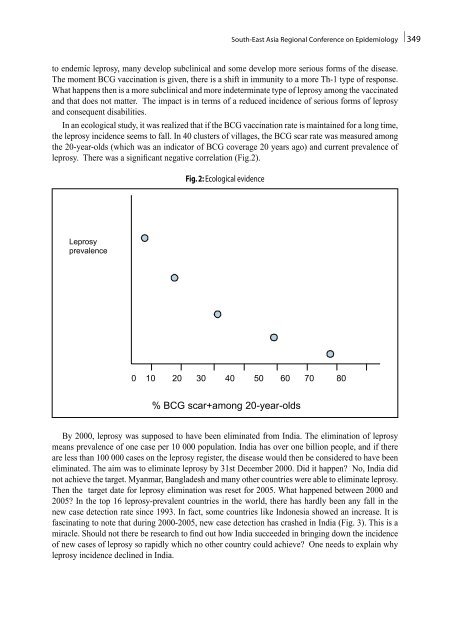South-East Asia Regional Conference on Epidemiology
South-East Asia Regional Conference on Epidemiology
South-East Asia Regional Conference on Epidemiology
Create successful ePaper yourself
Turn your PDF publications into a flip-book with our unique Google optimized e-Paper software.
<str<strong>on</strong>g>South</str<strong>on</strong>g>-<str<strong>on</strong>g>East</str<strong>on</strong>g> <str<strong>on</strong>g>Asia</str<strong>on</strong>g> <str<strong>on</strong>g>Regi<strong>on</strong>al</str<strong>on</strong>g> <str<strong>on</strong>g>C<strong>on</strong>ference</str<strong>on</strong>g> <strong>on</strong> <strong>Epidemiology</strong> | 349<br />
to endemic leprosy, many develop subclinical and some develop more serious forms of the disease.<br />
The moment BCG vaccinati<strong>on</strong> is given, there is a shift in immunity to a more Th-1 type of resp<strong>on</strong>se.<br />
What happens then is a more subclinical and more indeterminate type of leprosy am<strong>on</strong>g the vaccinated<br />
and that does not matter. The impact is in terms of a reduced incidence of serious forms of leprosy<br />
and c<strong>on</strong>sequent disabilities.<br />
In an ecological study, it was realized that if the BCG vaccinati<strong>on</strong> rate is maintained for a l<strong>on</strong>g time,<br />
the leprosy incidence seems to fall. In 40 clusters of villages, the BCG scar rate was measured am<strong>on</strong>g<br />
the 20-year-olds (which was an indicator of BCG coverage 20 years ago) and current prevalence of<br />
leprosy. There was a significant negative correlati<strong>on</strong> (Fig.2).<br />
Leprosy<br />
prevalence<br />
Fig. 2: Ecological evidence<br />
0 10 20 30 40 50 60 70 80<br />
% BCG scar+am<strong>on</strong>g 20-year-olds<br />
By 2000, leprosy was supposed to have been eliminated from India. The eliminati<strong>on</strong> of leprosy<br />
means prevalence of <strong>on</strong>e case per 10 000 populati<strong>on</strong>. India has over <strong>on</strong>e billi<strong>on</strong> people, and if there<br />
are less than 100 000 cases <strong>on</strong> the leprosy register, the disease would then be c<strong>on</strong>sidered to have been<br />
eliminated. The aim was to eliminate leprosy by 31st December 2000. Did it happen? No, India did<br />
not achieve the target. Myanmar, Bangladesh and many other countries were able to eliminate leprosy.<br />
Then the target date for leprosy eliminati<strong>on</strong> was reset for 2005. What happened between 2000 and<br />
2005? In the top 16 leprosy-prevalent countries in the world, there has hardly been any fall in the<br />
new case detecti<strong>on</strong> rate since 1993. In fact, some countries like Ind<strong>on</strong>esia showed an increase. It is<br />
fascinating to note that during 2000-2005, new case detecti<strong>on</strong> has crashed in India (Fig. 3). This is a<br />
miracle. Should not there be research to find out how India succeeded in bringing down the incidence<br />
of new cases of leprosy so rapidly which no other country could achieve? One needs to explain why<br />
leprosy incidence declined in India.









